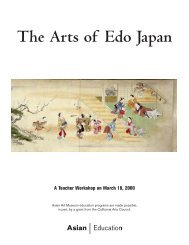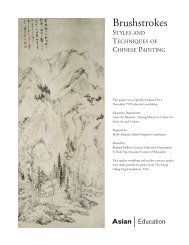Sacred Arts of Tibet (.pdf) - Asian Art Museum | Education
Sacred Arts of Tibet (.pdf) - Asian Art Museum | Education
Sacred Arts of Tibet (.pdf) - Asian Art Museum | Education
You also want an ePaper? Increase the reach of your titles
YUMPU automatically turns print PDFs into web optimized ePapers that Google loves.
Table <strong>of</strong> Contents<br />
<strong>Sacred</strong> <strong><strong>Art</strong>s</strong> <strong>of</strong> <strong>Tibet</strong><br />
Background Reading<br />
About this Packet<br />
The Land <strong>of</strong> <strong>Tibet</strong><br />
The People <strong>of</strong> <strong>Tibet</strong><br />
Nomads ~ Farmers ~ Monks and Nuns (the monastic community)<br />
Religious Practice in <strong>Tibet</strong><br />
Buddhism in <strong>Tibet</strong><br />
The Development <strong>of</strong> Buddhism in India<br />
Enlightenment and the Buddha’s Teachings<br />
Three Paths to Salvation<br />
The Bodhisattva<br />
Vajrayana Buddhism<br />
Bön, <strong>Tibet</strong>’s Indigenous Belief<br />
History<br />
The Age <strong>of</strong> Kings: The "First Transmission" <strong>of</strong> Buddhism to <strong>Tibet</strong> (approx. 400 BCE-<br />
850 CE)<br />
Songtsen Gambo (618-650), the First King <strong>of</strong> a Unified <strong>Tibet</strong><br />
Empress Wen Cheng and Empress Bhrikuti Help Establish Buddhism in <strong>Tibet</strong><br />
<strong>Tibet</strong>’s Important Ties with India<br />
Expansion <strong>of</strong> Emperor Songtsen Gambo’s Empire<br />
Padmasambhava, the “Lotus Born,” Confronts the Bön Deities<br />
Establishment <strong>of</strong> the First Buddhist Monastery in <strong>Tibet</strong><br />
Religious Rule: The “Second Transmission” <strong>of</strong> Buddhism to <strong>Tibet</strong> (Approx. 850-1000)<br />
Atisha (982-1054) and the revitalization <strong>of</strong> Buddhism<br />
Milarepa (1040-1123), <strong>Tibet</strong>’s Most Beloved Hero<br />
The Mongols and <strong>Tibet</strong><br />
Tsongkhapa (1357-1419), the Great Religious Reformer<br />
The Institution <strong>of</strong> Identifying Reincarnate Lamas (tulku) is Established<br />
The Origin <strong>of</strong> the Name <strong>of</strong> the Dalai Lama<br />
The Fifth Dalai Lama (1617-1682) Becomes Ruler <strong>of</strong> <strong>Tibet</strong>, Unites Spiritual and<br />
Temporal Power<br />
The Manchu Empire and <strong>Tibet</strong><br />
<strong>Tibet</strong> Today<br />
Slide Descriptions<br />
Activities<br />
Readings<br />
Appendices<br />
Bibliography<br />
2<br />
<strong>Asian</strong> <strong>Art</strong> <strong>Museum</strong>
















